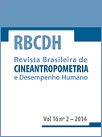A influência da terapia de libertação posicional sobre a tensão miofascial do músculo trapézio
DOI:
https://doi.org/10.1590/1980-0037.2014v16n2p191Resumen
O objetivo deste estudo foi analisar a influência da Terapia de Libertação Posi-cional (TLP) sobre a tensão miofascial do músculo trapézio superior, com presença de ponto gatilho (PG) miofascial ativo. Foram estudados 30 indivíduos (18 homens e 12 mulheres), idade média 34,5 +9,4 anos, com presença de PG ativo, no músculo trapézio superior, de um dos lados. Os PG foram avaliados em ambos os lados e foram considerados ativos quando era evocada uma dor local, disseminada e persistente, por palpação manual. Os indivíduos foram avaliados em três condições: (a) repouso basal, (b) contração concêntrica e (c) contração isométrica, antes e após da aplicação da TLP, nos seguintes parâmetros: (i) intensidade da dor durante a palpação (escala visual analógica de dor)e (ii) sinais eletromiográficos (EMG) do músculo trapézio superior. Houve uma redução significativa do sintoma doloroso 5,3 ± 1,9 para 2,8 ± 1,8 (p < 0,001). Quanto à atividade electromiográfica, em repouso basal e na contração concêntrica, não se observaram diferenças significativas nos sinais EMGs, após a utilização da TLP. Os resultados sugerem que a TLP diminui o sintoma doloroso e reduz os sinais da electromiografia, em repouso basal, do músculo trapézio superior com PG. Isto sugere que a técnica de TLP pode ser utilizada como uma alternativa ou em concomitância com outras terapias. A eficácia desta forma de tratamento deve ser confirmada por outros estudos clínicos.
Descargas
Publicado
Número
Sección
Licencia

Direitos Autorais para artigos publicados nesta revista são do autor, com direitos de primeira publicação para a revista. Em virtude da aparecerem nesta revista de acesso público, os artigos são de uso gratuito, com atribuições próprias, em aplicações educacionais e não-comerciais, desde que seja dada a atribuição. Esta obra foi licenciada com uma Licença Creative Commons Atribuição 4.0 Internacional - CC BY


